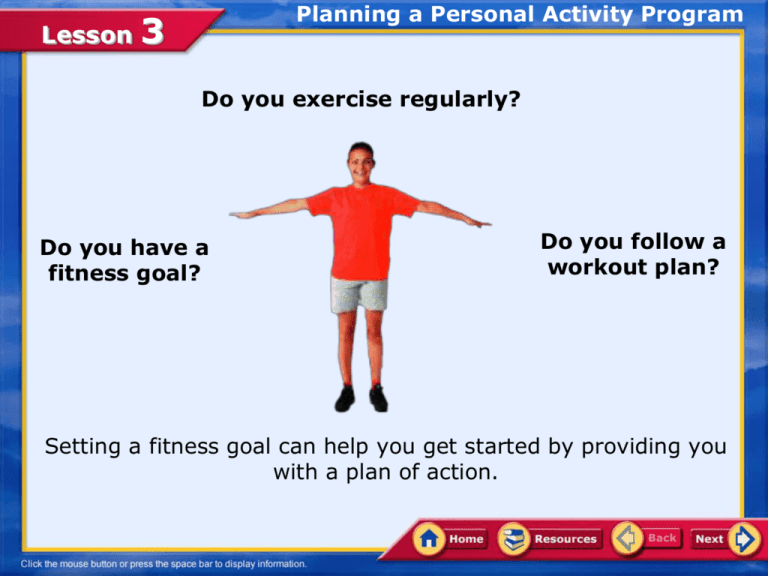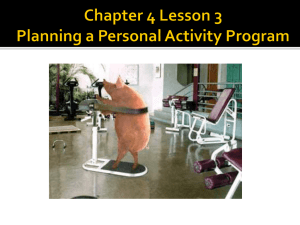Lesson 3
advertisement

Lesson Planning a Personal Activity Program 3 Do you exercise regularly? Do you have a fitness goal? Do you follow a workout plan? Setting a fitness goal can help you get started by providing you with a plan of action. Lesson 3 Lesson Objectives In this lesson, you will learn to: • Establish realistic fitness goals • Develop a personal physical activity program • Describe the basic principles of a physical activity program Lesson 3 Setting Physical Activity Goals Set Realistic Fitness Goals To meet the U.S. Department of Agriculture (USDA) recommendations, teens should get 60 minutes of physical activity every day. This may include activities ranging from participating in physical education classes and playing sports to doing household tasks. Lesson 3 Getting Started The Physical Activity Pyramid provides suggestions about how to divide your time when doing various types of physical activity. Setting Physical Activity Goals Lesson 3 Setting Physical Activity Goals Moderate-Intensity Physical Activities • About 30 minutes per day • Examples: Walking, climbing stairs, gardening or yard work, walking a dog, and housecleaning Lesson 3 Aerobic Activities • 3–5 days per week (20–60 minutes per session) • Examples: Cycling, brisk walking, running, dancing, in-line skating, playing basketball, and crosscountry skiing Setting Physical Activity Goals Lesson 3 Setting Physical Activity Goals Anaerobic Activities • 2–3 days per week (all major muscle groups) • Examples: Biceps curl, pushups, abdominal curl, bench press, calf raise, and shoulder press Lesson 3 Setting Physical Activity Goals Flexibility Activities • 2 or more days per week (all major joints) • Examples: Side lunge, step stretch, hurdler stretch, calf stretch, and yoga stretches Lesson 3 Sedentary Activities • Do infrequently. • Examples: Watching television, talking on the phone, playing computer games, and surfing the Internet Setting Physical Activity Goals Lesson 3 Choosing Activities Determining Factors Factors that may affect your decision making include: • Cost: Think about what you can afford. • Where you live: Choose activities that you can do locally. • Your level of health: Consider health conditions. • Time and place: Build your program into your daily routine. • Personal safety: Avoid going through unsafe areas. • Comprehensive planning: Address all five areas of fitness. Lesson 3 Choosing Activities Cross Training Engaging in a variety of physical activities to strengthen different muscle groups is known as cross training. Jumping rope, swimming, jogging, and cycling are good cross-training activities for athletes. Lesson 3 Basics of a Physical Activity Program Three Principles of Effective Fitness Programs Overload Progression Specificity Overload builds muscular strength and contributes to overall fitness. It is achieved by increasing repetitions or by doing more sets (groups of 6 to 12 repetitions) of an exercise. Lesson 3 Basics of a Physical Activity Program Basic Physical Activity Stages To gain the most benefit from an exercise program, you’ll want to include three basic stages for each activity. 1. Warm-up 2. Workout 3. Cool-down Lesson 3 Basics of a Physical Activity Program The Warm-Up The warm-up is the first stage in any physical activity routine. • Begin by taking a brisk walk to raise your body temperature. • Then, slowly stretch large muscles to increase their elasticity and reduce the risk of injury. • Perform the physical activity slowly for about five minutes. Lesson 3 Basics of a Physical Activity Program The Workout To be effective, the activity needs to follow the F.I.T.T. formula. Lesson 3 Basics of a Physical Activity Program Frequency • Schedule workouts three to four times each week, with only one or two days between sessions. • The frequency of your workouts depends partly on your fitness goals and the type of activity you do—as well as on your schedule and possibly even the weather. Lesson 3 Basics of a Physical Activity Program Intensity • Working your muscles and cardiorespiratory system at an intensity that allows you to reach overload will help you improve your fitness level. • When weight training, start with a light weight and build to heavier weights. • For aerobics, work toward your target heart range. Lesson 3 Basics of a Physical Activity Program Time/Duration • Slowly build up the amount of time you spend doing aerobic exercises. • The goal in aerobics is to work within your target heart range for 20 to 30 minutes. • When weight training, do the exercises slowly, taking at least two seconds to lower a weight. Also, vary the exercises to strengthen your muscles in the full range of motion. Lesson 3 Basics of a Physical Activity Program Type • To get the maximum health benefits from your workout routine, devote 75 to 80 percent of your workout time to aerobic activity and 20 to 25 percent to anaerobic activity. • Choose activities that you enjoy, or you may find it difficult to complete your workouts. Lesson 3 Basics of a Physical Activity Program The Cool-Down • Begin the cool-down by slowing down the activity. • Continue the activity at this slower pace for about five minutes. • Then, stretch for five minutes. Lesson 3 Monitoring Your Progress Fitness Journal To monitor your progress, keep a fitness journal. In your journal, list your goals and note the frequency, intensity, duration, and type of each activity in which you participate. Lesson 3 Monitoring Your Progress Resting Heart Rate Your resting heart rate can also be used to evaluate your progress. A resting heart rate below 72 indicates a good fitness level.






